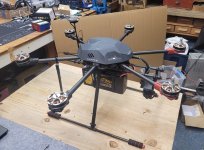I have only been a drone enthusiast for a couple of years. Since I began the hobby, I've always wanted to build a large multirotor. My first drone was a DJI Mini first generation drone. It was a good drone for the price but I do not like the cumbersome process of attaching a phone or tablet to the controller. Additionally, most phones and tablets aren't bright enough to see on a sunny day. The tablets that are bright enough cost $400 or more. Because of these issues all of my future drone purchases had remotes with built in screen. These remotes all have 700 or 1000 nit screen brightness which is usable in bright daylight.
Most DIY drone builders build FPV racing type drones and use goggles. These drones almost exclusively use traditional style RC Airplane transmitters. These transmitters come in a wide range of quality and price but few if any have video capability. When using these traditional RC transmitters, the only way to have display screen other than goggles is to buy a video signal receiver that can receive the live stream video transmitted by the drone. This typically involves a separate battery or power source, a monitor or display screen, a tripod to hold the screen (you have a huge transmitter in your hands) plus cables to connect to a battery and the receiver and antenna. It is a cumbersome process to set everything up before you can even fly the drone.
Just like all my consumer drones (DJI & FIMI) which have built in screen remote controllers, I wanted the same setup for my large DIY multirotor drone. Fortunately there are 3 or 4 companies that make these type of remotes for large custom drones. Skydroid, Herelink and SIYI are the main choices. These RC remote controllers are marketed and designed for Agricultural or industrial use. As such, there is a fairly steep learning curve. Even for automation engineers such as myself. I spent countless hours deciding which system I would buy. I chose the SIYI MK32 standard combo. This is a very large RC remote with a 7 inch built in screen. The Air Unit handles all the communications between drone and pilot. This includes flight control, telemetry feedback from the drone, and a live video feed. Traditional RC airplane remote controllers typically only provide a control/telemetry link to the aircraft. In addition to a display screen and receiver to receive the video signal, this fact necessitates installing an additional VTX transmitter on the drone (video signal transmitter). As I mentioned before, very cumbersome. Even with my fairly extensive knowledge of electronics and control systems, I still had to perform many hours of research to understand how to connect and program all of the components. In total, it took me over 3 months to build and program my first build.
If anyone wants detailed information on the components I've used and which software programs are involved, I'll be happy to share the knowledge I've gained. This is a hexacopter with 6 motors and propellers. It has a 5 mile range, an autopilot with most of the same automated flight programs found on premium DJI consumer drones. The camera is mounted on a high quality 3 axis gimbal, has a Sony 1/1.7 4k 8 megapixel Starlight Vision sensor and 6X zoom. I've also installed an AI tracking module. This drone can lift an additional payload weight of 5 pounds and uses 14 inch propellers. The flight time with a 6S 16000mAh battery is around 45 minutes.
I am in the process of building an even larger quad drone that will have a 1 hour flight time, can lift 15 pounds, and use propellers that are over 2 feet long!
Most DIY drone builders build FPV racing type drones and use goggles. These drones almost exclusively use traditional style RC Airplane transmitters. These transmitters come in a wide range of quality and price but few if any have video capability. When using these traditional RC transmitters, the only way to have display screen other than goggles is to buy a video signal receiver that can receive the live stream video transmitted by the drone. This typically involves a separate battery or power source, a monitor or display screen, a tripod to hold the screen (you have a huge transmitter in your hands) plus cables to connect to a battery and the receiver and antenna. It is a cumbersome process to set everything up before you can even fly the drone.
Just like all my consumer drones (DJI & FIMI) which have built in screen remote controllers, I wanted the same setup for my large DIY multirotor drone. Fortunately there are 3 or 4 companies that make these type of remotes for large custom drones. Skydroid, Herelink and SIYI are the main choices. These RC remote controllers are marketed and designed for Agricultural or industrial use. As such, there is a fairly steep learning curve. Even for automation engineers such as myself. I spent countless hours deciding which system I would buy. I chose the SIYI MK32 standard combo. This is a very large RC remote with a 7 inch built in screen. The Air Unit handles all the communications between drone and pilot. This includes flight control, telemetry feedback from the drone, and a live video feed. Traditional RC airplane remote controllers typically only provide a control/telemetry link to the aircraft. In addition to a display screen and receiver to receive the video signal, this fact necessitates installing an additional VTX transmitter on the drone (video signal transmitter). As I mentioned before, very cumbersome. Even with my fairly extensive knowledge of electronics and control systems, I still had to perform many hours of research to understand how to connect and program all of the components. In total, it took me over 3 months to build and program my first build.
If anyone wants detailed information on the components I've used and which software programs are involved, I'll be happy to share the knowledge I've gained. This is a hexacopter with 6 motors and propellers. It has a 5 mile range, an autopilot with most of the same automated flight programs found on premium DJI consumer drones. The camera is mounted on a high quality 3 axis gimbal, has a Sony 1/1.7 4k 8 megapixel Starlight Vision sensor and 6X zoom. I've also installed an AI tracking module. This drone can lift an additional payload weight of 5 pounds and uses 14 inch propellers. The flight time with a 6S 16000mAh battery is around 45 minutes.
I am in the process of building an even larger quad drone that will have a 1 hour flight time, can lift 15 pounds, and use propellers that are over 2 feet long!

